Education for a Digital World Advice, Guidelines and Effective Practice from Around Globe, 2008a
Education for a Digital World Advice, Guidelines and Effective Practice from Around Globe, 2008a
Education for a Digital World Advice, Guidelines and Effective Practice from Around Globe, 2008a
Create successful ePaper yourself
Turn your PDF publications into a flip-book with our unique Google optimized e-Paper software.
21 – Media Selection<br />
Selecting media<br />
The media mix you choose must be able to meet the<br />
requirements of the instructional strategy <strong>and</strong> address<br />
all of the instructional events. In particular, the media<br />
mix must effectively teach all of the learning outcomes<br />
<strong>and</strong> should allow <strong>for</strong> practice <strong>and</strong> feedback. Use the<br />
following general guidelines <strong>for</strong> selecting the appropriate<br />
media mix <strong>for</strong> the learning domains of verbal in<strong>for</strong>mation,<br />
intellectual skills, psychomotor skills, <strong>and</strong><br />
attitudes. (Learning domains are discussed in more detail<br />
in Chapter 10, General Principles of Instructional<br />
Design.)<br />
For verbal in<strong>for</strong>mation such as knowledge <strong>and</strong> comprehension,<br />
you should use text <strong>and</strong> visuals. Remember<br />
to use the computer to provide interaction as that can be<br />
difficult or cumbersome to do with paper-based materials.<br />
For intellectual skills such as applying skills to new<br />
examples, you can effectively use each medium depending<br />
on the skill being taught. Following the instructional<br />
design process will help you determine the<br />
best media mix.<br />
For psychomotor skills such as those requiring muscular<br />
actions, you should use real equipment although,<br />
<strong>for</strong> practical reasons such as cost <strong>and</strong> safety, you may<br />
need to create a simulation that incorporates a variety of<br />
media. Video with audio or text support can be superb<br />
<strong>for</strong> teaching psychomotor skills. Similarly, a series of<br />
images with text can also be very effective.<br />
Although you can use video <strong>and</strong> audio to effectively<br />
teach attitudes, <strong>for</strong> example, choosing to say “no” to<br />
drugs, your complete instructional strategy should consider<br />
other methods such as role-playing.<br />
Remember to consider learner characteristics as discussed<br />
in Chapter 10, General Principles of Instructional<br />
Design.<br />
Transferring material to other<br />
<strong>for</strong>mats<br />
If you simply transfer material <strong>from</strong> one storage <strong>for</strong>mat<br />
to another, the second’s advantages may not be exploited<br />
<strong>and</strong> the first’s limitations may be kept. For example,<br />
some analog videotapes have been transferred to<br />
CD-ROM. If the video clip is specifically designed to be<br />
played linearly, it may only be educationally sound to<br />
play the video linearly. In this case, the CD-ROM’s advantage<br />
of instant access capabilities <strong>and</strong> interaction are<br />
not being utilized. There may only be minimal value in<br />
having video contained on a CD-ROM instead of a<br />
videotape. In general, if material is designed specifically<br />
<strong>for</strong> one <strong>for</strong>mat, be careful about transferring it directly<br />
to another <strong>for</strong>mat. However, with modifications, transferring<br />
material <strong>from</strong> one <strong>for</strong>mat to another can be justified<br />
<strong>and</strong> effective.<br />
Note that there is often a quality loss in the image <strong>and</strong><br />
sound clarity when transferring materials between <strong>for</strong>mats.<br />
Working with original materials can minimize<br />
losses.<br />
Accessing media<br />
You will need to consider whether the students should<br />
access the media data (e.g., large video files) <strong>from</strong> a<br />
DVD-ROM, a CD-ROM, an intranet, or the Internet.<br />
This is summarized in Table 21.1.<br />
Summary<br />
A major part of the instructional design process you<br />
need to do is select the appropriate media mix to effectively<br />
teach the learning outcome(s). Selecting the best<br />
media mix will enable you to increase learning. The different<br />
media categories are: text, audio, visuals, video,<br />
animations, <strong>and</strong> real objects.<br />
The media you use can influence the amount of<br />
learning that occurs. If you combine the media’s<br />
strengths with instructional methods that take advantage<br />
of these strengths, you can positively influence<br />
learning. Learning <strong>from</strong> course content made with more<br />
than one medium is usually more effective than content<br />
comprised of only one medium. In many situations, you<br />
can <strong>and</strong> should use more than one medium to teach the<br />
skill. However, remember that if you use too many media<br />
at one time, you can impede learning. Base your<br />
media mix decision on the learning outcomes, how they<br />
are being taught, <strong>and</strong> how testing will be done. To be<br />
successful, students must also have the skills to extract<br />
in<strong>for</strong>mation <strong>and</strong> learn <strong>from</strong> the media. You may also<br />
need to motivate your students to learn <strong>from</strong> the media<br />
selected.<br />
You can effectively use text to teach many skills (most<br />
verbal in<strong>for</strong>mation, intellectual skills, <strong>and</strong> cognitive<br />
strategies <strong>and</strong> some psychomotor skills <strong>and</strong> attitudes)<br />
unless the target audience has a poor reading ability or<br />
low motivation. You will often need to combine text<br />
with other media.<br />
Text often <strong>for</strong>ms the foundation of online courses.<br />
Write text well by making text underst<strong>and</strong>able, minimizing<br />
reading, developing a good writing style, <strong>and</strong> following<br />
<strong>Education</strong> <strong>for</strong> a <strong>Digital</strong> <strong>World</strong> 335


















